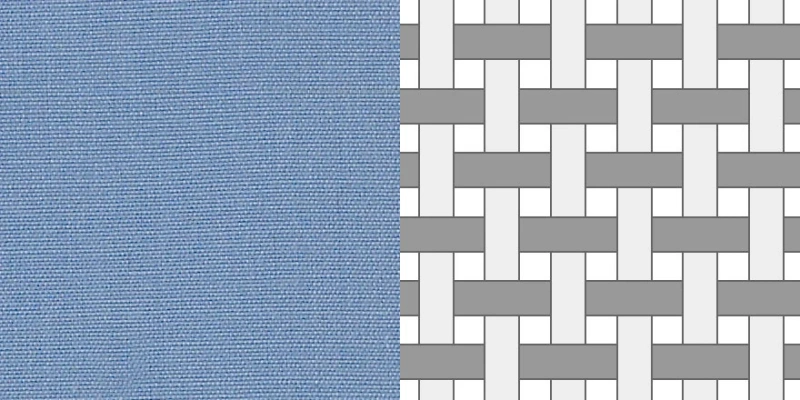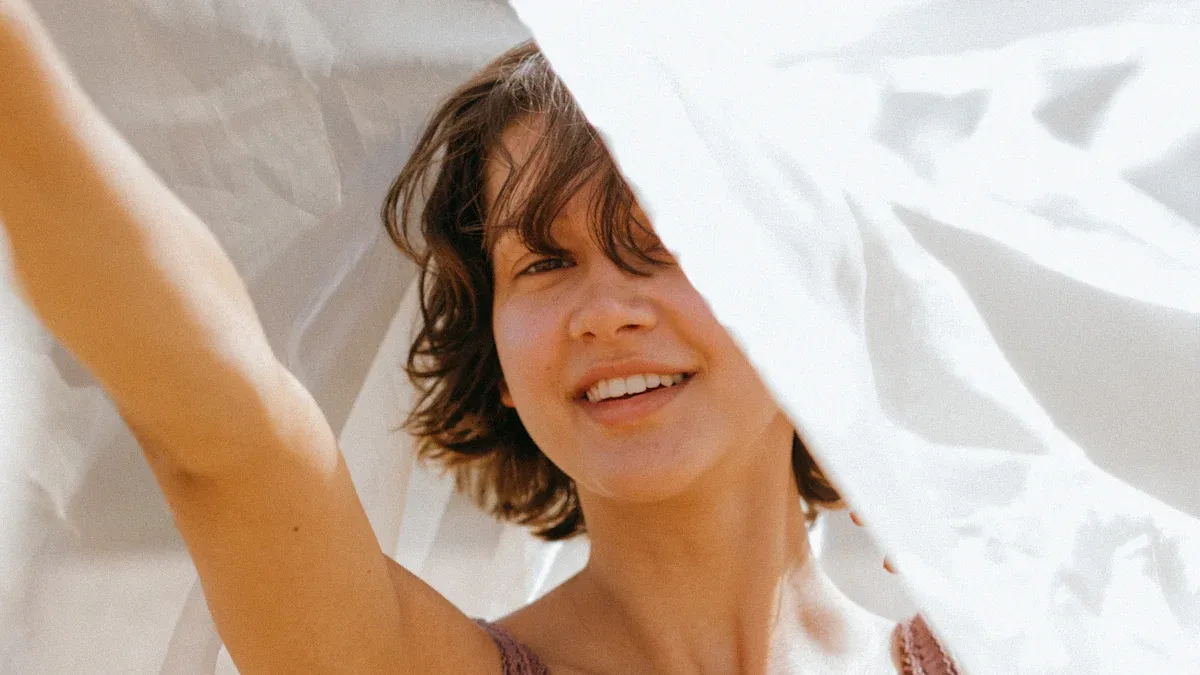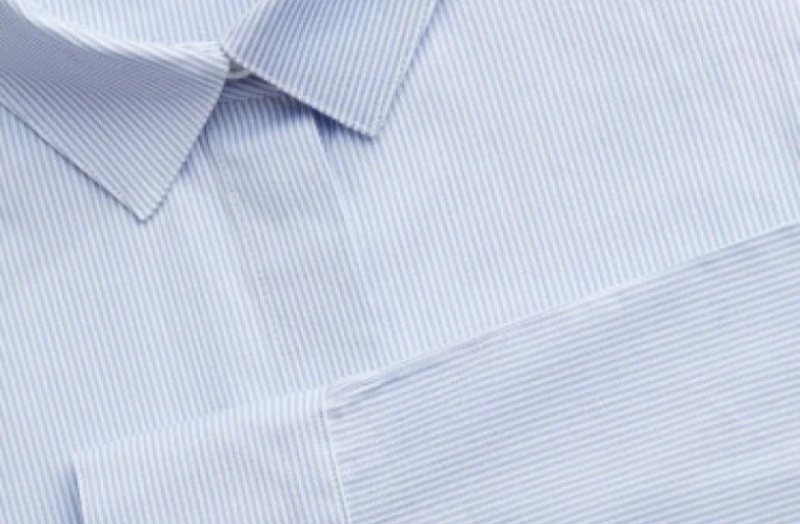When you think about poplin vs twill for summer shirts, poplin stands out as the best shirt fabric for hot days. You want your shirt to feel light, cool, and breathable when the temperature rises. Poplin checks all those boxes. It feels crisp and smooth against your skin.
Twill can look sharp, but it’s usually heavier. If you want to stay comfortable, check out the poplin options at Fanda Fabrics. Their poplin range keeps you feeling fresh even when the sun is blazing. Poplin vs twill comes down to what feels coolest, and poplin wins for summer.
Key Takeaways
Poplin fabric feels light, smooth, and breathable, making it the best choice for hot summer days.
Twill fabric is heavier and textured, offering more structure but less breathability for warm weather.
Poplin shirts dry quickly, stay cool, and look sharp, perfect for both casual and formal wear.
Twill shirts resist wrinkles and hold their shape well, but can feel warm in the heat.
Choose poplin for outdoor comfort and easy care; pick twill if you want a sturdy, textured look.
Poplin vs Twill Overview
Poplin Basics
When you look for a shirt that feels cool and crisp, poplin stands out. This fabric uses a plain weave, which gives it a smooth surface and a lightweight feel. You notice the subtle horizontal ribs if you look closely.
Poplin feels soft against your skin and lets air flow easily, making it a favorite for summer. You can wear poplin shirts to work, to dinner, or just for a walk in the park. They keep you comfortable and stylish all day.
If you want high-quality shirting, poplin is a top pick. Fanda Fabrics offers a wide range of poplin options, including cotton poplin, woven poplin, and even poly poplin. You get to choose from different colors, weights, and finishes.
Their poplin fabrics work well for both casual and formal shirts. You can even find poplin lining fabric for extra comfort inside your garments.
Tip: If you want a shirt that stays cool and looks sharp, try a poplin shirt from Fanda Fabrics.
Twill Basics
Twill brings a different vibe to your wardrobe. You spot twill by its diagonal weave pattern, which gives the fabric a bit more texture and weight. Twill fabric feels sturdy and holds its shape well.
You often see twill in dress shirts, chinos, and even jackets. The fabric drapes nicely and resists wrinkles, so you look polished with less effort.
When you compare poplin vs twill, you notice that twill feels heavier and a bit warmer. It works great for cooler days or when you want a shirt with more structure. Twill shirts can look dressy or casual, depending on the color and cut. If you like a shirt with a bit more body and a unique texture, twill might be your go-to.
Poplin vs twill comes down to what you want in a shirt. Poplin keeps you cool and light, while twill gives you structure and a classic look.
Weave and Structure
Poplin Weave

When you pick up a poplin shirt, you notice how smooth and crisp it feels. That comes from the way poplin is woven. Poplin uses a plain weave, which means the threads cross over and under each other in a simple, tight pattern.
This creates a flat surface with very fine, almost invisible ribs running across the fabric. You get a shirt that feels light and cool, perfect for hot days.
The plain weave gives poplin its signature look and feel. You won’t see much texture, but you will feel the difference. Poplin shirts stay breathable and soft, so you can wear them all day without feeling weighed down.
If you want a shirt that looks sharp and feels fresh, poplin is a great choice. Many people love poplin for its clean finish and easy comfort.
Note: Poplin’s tight weave helps it resist snags and keeps your shirt looking new longer.
Twill Weave
Twill stands out because of its unique weave. When you look closely at twill, you see diagonal lines or ridges running across the fabric. This happens because twill weave uses a pattern where the threads cross over two or more threads before going under. The result is a fabric with a distinct texture and a bit more weight.
Twill fabric feels thicker and more substantial than poplin. You might notice that twill drapes nicely and holds its shape well. The diagonal weave also helps hide wrinkles and stains, which makes twill a popular choice for work shirts and dressier looks. If you like a shirt with a bit of texture and a classic vibe, twill could be your go-to.
Here’s a quick comparison to help you see the difference:
Feature | Poplin | Twill |
|---|---|---|
Weave Pattern | Plain (over/under) | Diagonal (over multiple) |
Texture | Smooth, flat | Textured, ridged |
Weight | Light | Medium to heavy |
You get a different feel and look with each weave. Poplin keeps things light and airy, while twill brings structure and style.
Weight and Breathability

Poplin for Summer
When you want to stay cool in the heat, poplin makes a big difference. This fabric feels light as air on your skin. You can wear a poplin shirt all day and barely notice it. The plain weave lets air move through the fabric, so you never feel stuffy or sweaty.
Poplin dries quickly if you do start to sweat, which helps you stay fresh even on the hottest days.
You might wonder why poplin works so well for summer shirts. The answer is in the fabric’s structure. Poplin uses fine yarns and a tight weave, but it never feels heavy. You get a crisp, smooth shirt that breathes better than most other fabrics. If you want a shirt that keeps you cool at work, on vacation, or just hanging out, poplin is a smart pick.
Fanda Fabrics offers cotton poplin and woven poplin that are perfect for summer. Their cotton poplin feels soft and natural, while the woven poplin gives you a bit more structure without losing breathability. You can choose from lots of colors and weights, so you always find something that fits your style and comfort needs.
Tip: Try a poplin shirt from Fanda Fabrics if you want to beat the heat and look sharp at the same time.
Twill for Summer
Twill brings a different feel to your summer wardrobe. This fabric has a heavier weight and a tighter weave than poplin. You notice the difference as soon as you put on a twill shirt. It feels thicker and less airy. The diagonal weave gives twill its signature texture, but it also means less airflow.
You might like twill for its durability and the way it holds its shape. Twill shirts look crisp and resist wrinkles, which is great for busy days. But when the temperature climbs, twill can start to feel warm. The fabric traps more heat, so you may not feel as cool as you would in poplin.
Some people still choose twill for summer, especially if they want a shirt with more structure or a unique look. If you spend most of your time in air-conditioned spaces, twill can work. But if you plan to be outside or want maximum breathability, poplin usually wins.
Here’s a quick list to help you decide:
Choose poplin if you want a lightweight, breathable shirt for hot days.
Pick twill if you prefer a shirt with more body and don’t mind a bit of extra warmth.
Note: For the best summer comfort, cotton poplin and woven poplin from Fanda Fabrics give you the airflow and lightness you need.
Comfort and Feel
Poplin Texture
When you touch a poplin shirt, you notice how smooth it feels right away. The fabric has a crisp surface that glides against your skin. You do not feel any roughness or heavy texture.
Poplin provides a clean, almost silky texture, making it perfect for summer shirts. You can wear it all day and still feel comfortable. The fabric does not cling or trap heat, so you stay cool even when the sun is out.
If you like shirts that feel light and fresh, poplin is a great choice. The tight weave keeps the fabric soft but strong. You get a shirt that holds its shape but never feels stiff.
Many people say poplin feels gentle, almost like a second skin. You can move easily, and the fabric does not bunch up or wrinkle much. This makes poplin a favorite for anyone who wants comfort and style in one package.
Tip: If you want a shirt that feels smooth and stays cool, try poplin from Fanda Fabrics. You will notice the difference as soon as you put it on.
Twill Texture
Twill has a different feel compared to poplin. When you run your hand over twill, you notice the diagonal ridges. The fabric feels thicker and more textured. Some people like this extra body because it gives shirts a bit more structure. Twill feels sturdy, so you know your shirt will last a long time.
You might find twill shirts feel warmer than poplin. The texture adds weight, which can make the fabric less breathable. If you like a shirt that feels solid and holds its shape, twill is a good pick. The fabric drapes nicely and resists wrinkles, so you look sharp with less effort.
Here’s a quick comparison to help you decide:
Poplin: Smooth, crisp, lightweight, and cool on the skin.
Twill: Textured, sturdy, heavier, and holds its shape well.
You get a different experience with each fabric. Think about what feels best for you before you choose.
Appearance and Style
Poplin Look
When you slip on a poplin shirt, you notice the clean, crisp finish right away. Poplin has a smooth surface that reflects light softly, giving your shirt a subtle sheen. This fabric looks sharp and polished, even after a long day. You don’t see much texture, so the shirt always appears neat.
Poplin works well for both casual and formal shirts. You can wear a poplin button-down to the office or dress it down with jeans for a weekend outing. The fabric holds color beautifully, so you get vibrant whites, deep blues, or any shade you like. Patterns and prints also look clear and sharp on poplin, thanks to its tight weave.
Tip: If you want a shirt that looks fresh and put-together, poplin is a great choice. It gives you a classic style that never goes out of fashion.
Here’s what you get with poplin:
Smooth, flat surface with almost no texture
Subtle shine that looks clean and professional
Crisp lines that keep your outfit looking sharp
Colors and prints that stand out
You can find a wide range of poplin styles at Fanda Fabrics, so you always have options for your summer wardrobe.
Twill Look
Twill brings a different kind of style to your closet. When you look at a twill shirt, you spot the diagonal lines or ridges right away. This pattern gives twill a bit more depth and character. The fabric feels a little heavier, and the texture stands out more than poplin.
Twill shirts often look more relaxed and casual, but you can dress them up too. The fabric drapes nicely, so your shirt keeps its shape and looks structured. Twill also hides wrinkles better, which means you look polished with less effort.
Here’s a quick table to help you compare:
Feature | Poplin | Twill |
|---|---|---|
Surface | Smooth, flat | Textured, diagonal |
Shine | Subtle sheen | Matte or soft luster |
Style | Crisp, classic | Relaxed, structured |
If you like a shirt with a bit more texture and a unique look, twill might be your pick. You get a shirt that stands out in a crowd and feels sturdy every time you wear it.
Durability and Care
Poplin Maintenance

Taking care of your poplin shirts is pretty simple. You can toss most poplin shirts in the washing machine. Use cold or lukewarm water and a gentle cycle. This helps keep the fabric smooth and stops it from shrinking too much. Always use a mild detergent. Harsh chemicals can wear down the fibers over time.
After washing, you can hang your poplin shirt to dry or use a low heat setting in the dryer. Poplin dries quickly, so you do not have to wait long. If you want your shirt to look extra crisp, give it a quick iron on a medium setting. Poplin does not wrinkle much, but a little ironing keeps it looking sharp.
Tip: Always check the care label before washing. Some poplin shirts have special finishes or prints that need extra care.
If you buy poplin from Fanda Fabrics, you get a fabric that holds up well to regular washing. The colors stay bright, and the fabric keeps its shape. You do not need to worry about fading or pilling if you follow these easy steps.
Twill Maintenance
Twill shirts need a bit more attention, but you can still keep them looking great with the right care. Wash twill in cold water to help the fabric last longer. Twill is a bit heavier, so it may take longer to dry. You can hang your shirt or use a low heat dryer setting.
Twill resists wrinkles better than poplin, so you might not need to iron as often. If you do iron, use a medium heat and press along the diagonal lines for a smooth finish. Twill can sometimes hold onto stains, so treat any spots before washing.
Here’s a quick checklist for twill care:
Wash in cold water
Use a gentle detergent
Hang or tumble dry on low
Iron if needed, following the weave
Note: Twill shirts from quality sources will keep their color and texture if you care for them properly.
With these tips, you can enjoy your twill shirts for years. They stay sturdy and stylish, even after many washes.
Pros and Cons for Summer
Poplin Pros & Cons
When you shop for summer shirts, you want to know what makes poplin a smart choice. Here’s a quick look at the upsides and a few things to keep in mind:
Pros:
Feels lightweight and cool on your skin, even on the hottest days.
Let’s air flow easily, so you stay fresh and dry.
Has a smooth, crisp finish that looks sharp for work or play.
Dries quickly after washing, which makes laundry day easier.
Works well for both casual and dress shirts.
Cons:
Shows wrinkles a bit more than heavier fabrics.
May not feel as warm if you step into a chilly room.
Tip: If you want a shirt that keeps you comfortable all summer, poplin is hard to beat. You get a fabric that feels light and looks polished.
Twill Pros & Cons
Twill brings a different set of strengths to your closet. Here’s what you can expect when you pick a twill shirt for summer:
Pros:
Feels sturdy and holds its shape well, even after many wears.
Hides wrinkles and stains better than most lightweight fabrics.
Offers a unique texture with its diagonal weave, adding style to your look.
Drapes nicely, so your shirt always looks neat.
Cons:
Feels heavier and warmer, which can trap heat on hot days.
Allows less airflow, so you might not feel as cool outdoors.
Feature | Poplin (Best for Summer) | Twill (Best for Structure) |
|---|---|---|
Weight | Light | Medium to heavy |
Breathability | Excellent | Moderate |
Texture | Smooth | Textured |
Wrinkle Resistance | Moderate | High |
Note: If you spend most of your time in air conditioning, twill can still work. For outdoor adventures, poplin usually keeps you cooler.
Choosing the Right Fabric
Climate Considerations
Think about your local weather before you choose a shirt fabric. If you live somewhere hot or humid, you want a shirt that keeps you cool. Poplin works best for these conditions. The fabric feels light and lets air move through, so you stay comfortable even on the hottest days.
Twill feels heavier and holds in more heat. If you spend a lot of time outdoors or in the sun, poplin will help you feel fresh. You can find great options at Fanda Fabrics, including cotton poplin and woven poplin, both perfect for summer.
Tip: If you want to beat the heat, go for a poplin shirt. You will notice the difference right away.
Style Preferences
Your style matters when picking a fabric. Do you like a crisp, smooth look? Poplin gives you a clean finish and a classic style that works for both work and play. The fabric holds color well, so your shirt always looks bright and sharp.
If you want a shirt with more texture and a bit of weight, twill might fit your style better. Twill shirts have a unique diagonal pattern and feel more structured. Think about how you want your shirt to look and feel before you decide.
Care Needs
How much time do you want to spend on laundry? Poplin shirts are easy to care for. You can wash them at home, and they dry quickly. A quick iron keeps them looking crisp.
Twill shirts resist wrinkles, but they take longer to dry and may need a bit more care if they get stained. If you want something simple and low-maintenance, poplin is a smart choice. Fanda Fabrics offers poplin options that stay bright and hold their shape, even after many washes.
Note: For summer comfort, easy care, and a sharp look, poplin from Fanda Fabrics is hard to beat.
Conclusion
When you want the best summer shirt, poplin stands out. You get a fabric that feels light, cool, and smooth on your skin. Poplin lets air flow, so you stay comfortable even on the hottest days.
Twill works for structure, but poplin wins for breathability. Think about your climate, style, and how much care you want to give your shirts. Want to stay cool? Check out the poplin collection at Fanda Fabrics.
Tip: Try a poplin shirt this summer—you’ll feel the difference!
FAQ
What makes poplin better than twill for summer shirts?
Poplin feels lighter and lets your skin breathe. You stay cooler on hot days. Twill feels heavier and holds in more heat. If you want comfort in summer, poplin is the way to go.
Can I machine wash my poplin shirts?
Yes, you can! Use cold or lukewarm water and a gentle cycle. Poplin dries quickly and keeps its shape. For best results, hang your shirt or use a low heat dryer.
Does poplin wrinkle easily?
Poplin can show some wrinkles, but they smooth out fast with a quick iron. You get a crisp look without much effort. If you want a shirt that always looks sharp, poplin is a great choice.
Is cotton poplin from Fanda Fabrics good for sensitive skin?
Absolutely! Cotton poplin from Fanda Fabrics feels soft and gentle. It uses 100% cotton, so it works well for sensitive skin. You get comfort and breathability all day.
How do I choose the right poplin fabric at Fanda Fabrics?
Tip: Think about color, weight, and finish. Fanda Fabrics offers lots of options. If you want something light for summer, pick a lightweight cotton poplin. You can always ask their team for advice!
